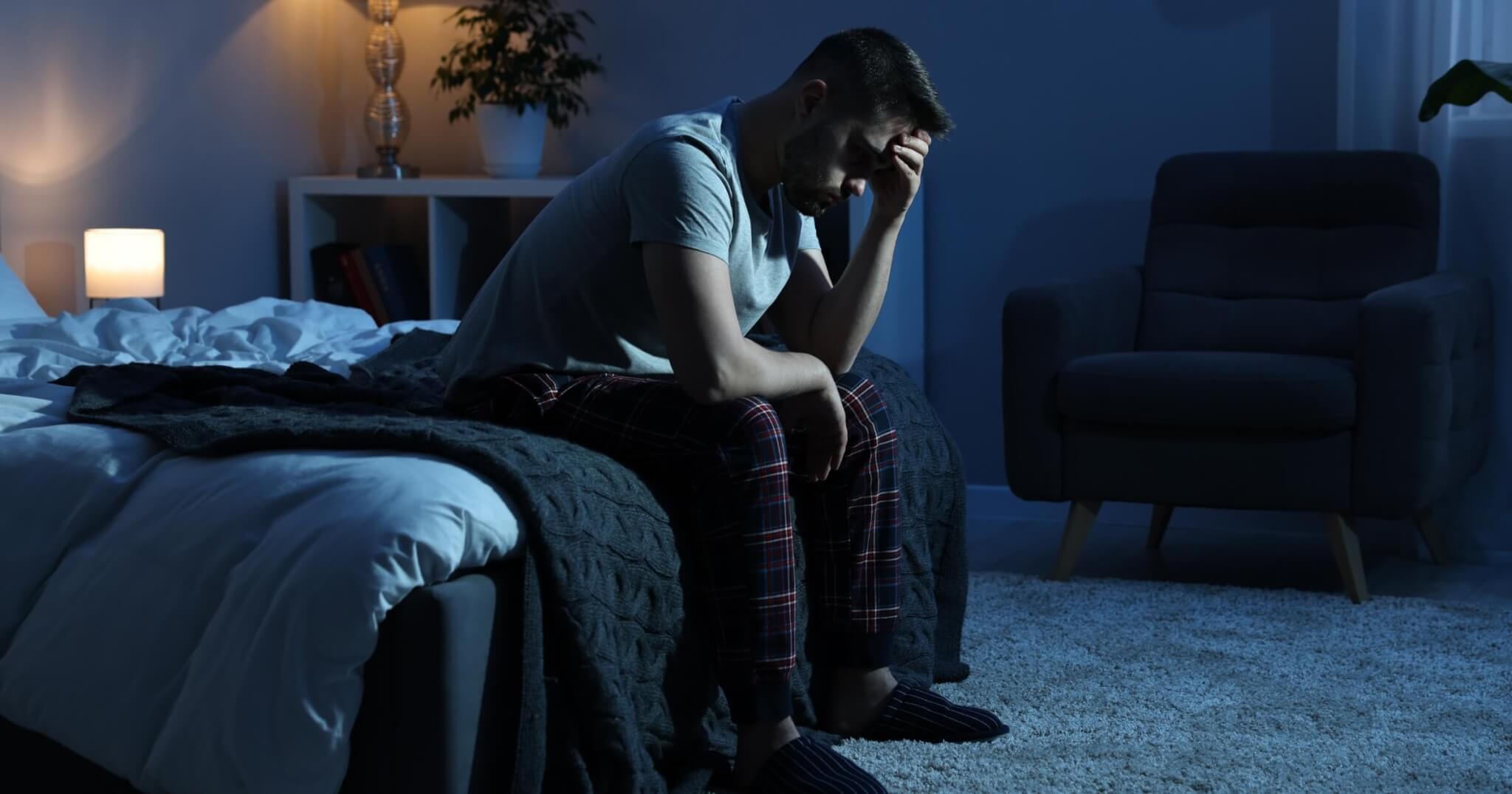Nighttime anxiety flares when the busy distractions of the day fade away, leaving worries unchecked. It makes it harder to relax into sleep, even if you’re exhausted. In this guide, we’re going to talk about proven techniques known to reduce nighttime anxiety like deep breathing, progressive muscle relaxation, and how to create calming bedtime routines.
You’ll also learn why anxiety at night is different from daytime stress and when to seek professional support. By the end, you’ll have a toolbox of non-medication strategies to quiet your mind and get a full night’s rest.
Quick look
- Nighttime anxiety often worsens when external distractions fade, allowing worries to feel more intense and overwhelming.
- Common symptoms include racing thoughts, muscle tension, a rapid heartbeat, frequent awakenings, and even nocturnal panic attacks.
- Hormonal imbalances, fear of losing control, and a lack of coping distractions all contribute to why anxiety at night feels different from daytime stress.
- Effective techniques to reduce nighttime anxiety include progressive muscle relaxation, deep breathing, guided imagery, and limiting screen time before bed.
- If anxiety disrupts sleep several nights a week or leads to daytime fatigue, it may be time to seek help from a mental health professional.
What is nighttime anxiety?
Nighttime anxiety refers to the surge of worry, restlessness, or panic that kicks in around bedtime. Unlike daytime anxiety, it often involves racing thoughts about the future, self-judgment about productivity, or buried fears resurfacing. Excessive worry and fear in the evening can prevent both falling asleep and staying asleep. In some cases, nighttime anxiety escalates into nocturnal panic attacks that wake people in the early hours. Recognizing these patterns helps distinguish them from general stress and points toward solutions that are specific to bedtime.
Why anxiety worsens at night
Hormonal shifts
At night, your body’s stress hormone cortisol should naturally drop to help you rest, with levels rising again in the early morning to promote waking. But for those with anxiety, this rhythm is often disrupted. Instead of cortisol going down, it remains elevated well into the night.
This imbalance keeps the nervous system activated and fuels a state of hyperarousal, where your body remains alert instead of winding down. You may feel tense or jittery even if nothing specific is bothering you. These physiological cues trick your brain into thinking you’re in danger, which makes relaxation nearly impossible.
Fear of losing control
For many anxious individuals, surrendering is deeply uncomfortable. The fear of being “unaware” or losing control while asleep can make bedtime feel threatening rather than peaceful. This fear may lead to habits such as repeatedly checking the clock, keeping the lights on, or mentally rehearsing the next day which are all attempts to maintain a sense of control. Ironically, these behaviors increase stimulation and prevent sleep. When sleep itself becomes a trigger, the anxiety builds night after night.
Lack of coping distractions
During the day, physical activity, conversation, social media, or even household chores can help redirect anxious thoughts. If you’re busy focusing on something else, you are less likely to dwell excessively on specific fears or concerns. However, at night, when those buffers fade, unresolved issues can resurface. Without something to redirect your focus, insecurities about work, health, relationships, or past mistakes often grow louder. This lack of stimulation gives anxiety more room to expand, which is why nighttime often feels more emotionally intense.
Common signs of nighttime anxiety
- Racing thoughts: When nighttime anxiety kicks in, thoughts often dart from one worry to another—“Did I forget something?” or “What if tomorrow goes wrong?” This constant mental chatter makes it hard to shut off your brain, especially in a quiet bedroom with no distractions.
- Restlessness and physical tension: Anxiety shows up in your body too. You may feel tight shoulders, a clenched jaw, or twitchy, restless legs that make it uncomfortable to lie still. These symptoms can be so persistent that they override your body’s natural signals for rest.
- Frequent awakenings: Some people wake multiple times during the night, sometimes without realizing why. These awakenings are frequently paired with a flood of intrusive thoughts or a jolt of worry, restarting the anxiety loop in the middle of the night. Even if you’re only awake for a few minutes, these interruptions can reduce the amount of deep, restorative sleep you get.
- Racing heart and shortness of breath: A sudden spike in heart rate or difficulty breathing can feel terrifying when it happens during sleep. Anxious thoughts or stress hormones often trigger these sensations, but your brain may misinterpret them as a sign of danger.
- Panic attacks: Some people experience full-blown panic attacks during the night, often waking suddenly with intense fear or a sense of doom. These episodes may include a racing heart, shaking, sweating, dizziness, or a feeling of choking. Unlike daytime panic attacks, these can feel especially disorienting because they strike during what’s supposed to be your most vulnerable, restful hours.
8 strategies to reduce nighttime anxiety before bed

Photo courtesy of https://www.shutterstock.com/
If you’re struggling to manage your nighttime anxiety, these strategies can help you calm your mind and body before sleep. The key is to not put any pressure on yourself for this to work immediately and instead focus on building a nightly habit that your body comes to associate with safety and rest.
1. Progressive muscle relaxation and guided imagery
Start by tensing and releasing each muscle group—feet, legs, hips, arms, shoulders, face—one at a time while breathing slowly. Add guided imagery by visualizing a calm scene, such as a beach or meadow, paired with muscle relaxation. When starting out, it’s best to use apps like Calm or Insight Timer which offer guided muscle relaxation meditations to learn the process.
These methods reduce physical tension and shift attention away from racing thoughts. Regular practice can help your nervous system switch from “fight or flight” to “rest and digest.” Once you learn the basics, try pairing this with calming music or ambient nature sounds for deeper immersion and better results.
2. Deep breathing exercises
Practice techniques like box breathing (inhale 4 seconds, hold 4, exhale 4, hold 4) or 4‑7‑8 breathing (inhale 4, hold 7, exhale 8). These slow the heart rate and activate the parasympathetic system.
To start, place a hand on your chest to keep breathing steady and grounded. Then slowly begin the breathing method and perform it for five to ten minutes. Focus on feeling the sensations in your body and give the tension a number. As you practice you’ll notice that the tension begins to fade and reduces.
Repeat this for several minutes until you feel calmer. Overtime, the effects should help you reduce nighttime anxiety symptoms. You can do this lying in bed or sitting up, whatever is more comfortable to you. What matters most is slowing down your breath and maintaining consistency night after night.
3. Guided meditation
Meditation has been around for centuries and its effects are well documented. There are several free apps and even YouTube instructors that can help guide you through one. The key is finding one that resonates with you. This may take a few tries but it’s well worth it as once you do find the right meditations, it’s far easier to sit calmly and enjoy the process.
When meditating, focus on your breath and acknowledge distracting thoughts without judgment and allow them to drift away. This practice helps separate you from persistent anxiety loops. Even a few minutes of stillness can reduce nighttime cortisol levels and give your mind space to let go of your anxiety.
4. Limit screen time and stimulation
Avoid blue-light screens at least an hour before bed. Devices boost alertness and trigger stress pathways thanks to both light and content. Switch to soft book reading, gentle stretches, or low-stim games instead. Reducing stimulation gives your brain space to wind down. If screens are unavoidable, use blue-light filters or night mode to reduce the impact.
5. Build a relaxing bedtime routine
Building a relaxing bedtime routine is one of the best ways of how to reduce nighttime anxiety. By maintaining consistent sleep and wake time, you can help to regulate your biological clock. Along with consistent sleep times, a bedtime routine such as quiet time with a warm beverage or journal writing signals to your body that it should start preparing for sleep. This helps settle the mind and reinforce bedtime associations. Include low-stimulus activities, such as puzzle books, sketching, or soft music, to strengthen the wind-down cue. Routines are essential during stressful weeks when your sleep might otherwise suffer.
6. Use sensory cues like warm showers or soft lighting
A warm shower or bath raises your core temperature, which then drops afterward, triggering drowsiness. Soft, amber lighting in your bedroom signals calm and reduces alertness. Aromas like lavender can also lower stress levels. These sensory signals shift your nervous system toward rest. Over time, your body may come to associate these cues with safe and restful sleep, thereby reducing anticipatory anxiety.
7. Avoid stimulants before bed
Cut caffeine (found in coffee, tea, soda, chocolate) and nicotine late in the day. Health authorities recommend a cutoff at least six hours before bedtime. Even small amounts of caffeine can affect the sleep of sensitive individuals. It’s also important to limit your alcohol consumption as it disrupts REM cycles and increases anxiety later in the night. Make sure to monitor your intake throughout the day to prevent buildup that interferes with sleep onset.
8. Use calming herbal supports
Herbal aids like chamomile, valerian root, or passionflower can ease tension before bed. Regular use may help lower stress hormones and promote better sleep. Opt for caffeine-free teas or low-dose supplements, and monitor for any side effects. Use them as part of the wind-down routine, not a crutch. For optimal results, combine herbal supports with other sleep hygiene practices, such as reducing screen time and practicing deep breathing.
When to seek professional help
Nighttime anxiety that starts affecting daily functioning may require support. If panic attacks disrupt sleep or if your mind consistently races for several nights per week, consult a mental health provider. Cognitive Behavioral Therapy for Insomnia (CBT‑I) can help reset unhelpful sleep habits and reduce sleep-focused worry.
A doctor may also evaluate for underlying conditions like anxiety disorders, sleep apnea, or hyperthyroidism. In severe cases, short-term medication alongside therapy might be recommended. Getting help early can prevent anxiety from becoming entrenched and maintain long-term sleep quality.
Final thoughts
Nighttime anxiety can make your bedroom feel like a battleground between peace and worry. But you don’t have to fight it with medication. By learning how to reduce nighttime anxiety, practicing deep breathing, muscle relaxation, gentle routines, and mindfulness, you can reclaim restful evenings. Morning comes easier when you’ve taken steps the night before. If daily worry persists, seeking professional help can bring relief and ultimately lead to improved sleep.
For more ways to look after your mental health and improve your sleep, check out these related reads:
- Does construction stress have you clenching your jaw? Here are 4 tips to help you stop
- Mental health resources for executives
- Emotional endurance
- Poor sleep and construction: 7 health conditions linked to it and what you can do about it
Want more strategies for managing stress on and off the job? Subscribe to the Under the Hard Hat newsletter for actionable, expert-backed advice:



